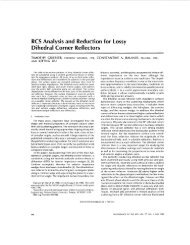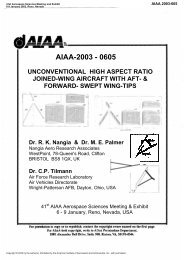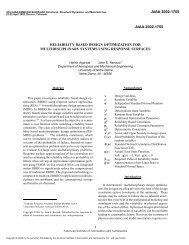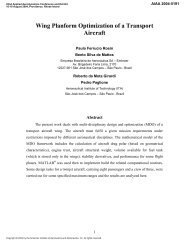Computer prediction of RCS for military targets ... - IEEE Xplore
Computer prediction of RCS for military targets ... - IEEE Xplore
Computer prediction of RCS for military targets ... - IEEE Xplore
You also want an ePaper? Increase the reach of your titles
YUMPU automatically turns print PDFs into web optimized ePapers that Google loves.
land vehicle. As represented to the <strong>prediction</strong> model, it is<br />
made up <strong>of</strong> flat conducting plates in an orthogonal<br />
arrangement (Fig. 1).<br />
Fig. 1 Box-like target<br />
An experimental plot taken from a set <strong>of</strong> full-scale <strong>RCS</strong><br />
measurements <strong>of</strong> the real target is shown in Fig. 2 <strong>for</strong> an<br />
elevation sweep in a plane parallel to the major axis <strong>of</strong><br />
the box. A corresponding theoretical plot is shown in Fig.<br />
3. Comparison illustrates a number <strong>of</strong> features typical <strong>of</strong><br />
this type <strong>of</strong> theoretical <strong>prediction</strong>, and the simplicity <strong>of</strong><br />
dam<br />
Fig. 2 Box-like target: experimental results<br />
<strong>RCS</strong> in decibels relauve lo 1 m' <strong>for</strong> ekvations 0" lo 180-; 35 GHz, HH polarisation<br />
dBm'<br />
Fig. 3 Box-like target: predicted results<br />
Ray density MO x MO m-*; <strong>RCS</strong> in decibels relative to I m2 <strong>for</strong> elevations 0" to<br />
180"; 35 GHz; HH polarisation<br />
the geometry permits a clear demonstration <strong>of</strong> the effects<br />
<strong>of</strong> some <strong>of</strong> the modelling assumptions.<br />
(i) The overall <strong>for</strong>m <strong>of</strong> the signature, including the<br />
positions and characters <strong>of</strong> the main lobes and peaks, is<br />
correctly predicted.<br />
(ii) The narrow sidelobes occurring at elevations <strong>of</strong><br />
about 20" and below are not predicted. This is due to the<br />
truncation <strong>of</strong> the ray path tree, in this case at depth four:<br />
a simple analysis shows that the missing lobes arise as<br />
multiple specular reflections <strong>of</strong> six bounces or more. Such<br />
peaks are usually <strong>of</strong> narrow angular extent, <strong>for</strong> geometri-<br />
cal reasons.<br />
IEE PROCEEDINGS, Vol. 137, Pt. F, No. 4, AUGUST 19W<br />
(iii) The fine modulations <strong>of</strong> the main lobes are not<br />
predicted. This fine structure is thought to be mainly due<br />
to higher order diffraction effects; but the necessary<br />
multiple diffraction rays are not included in the system.<br />
This shows, there<strong>for</strong>e, another type <strong>of</strong> effect <strong>of</strong> truncating<br />
the ray tree.<br />
(iv) Further inaccuracies will be attributable to differ-<br />
ences between the modelled and actual <strong>targets</strong>. These<br />
might arise either as deliberate modelling simplifications<br />
(as in the present case), or as inevitable perturbations <strong>of</strong><br />
the real target from mathematical exactness. The latter<br />
might include deviations from true planarity or ortho-<br />
gonality. None <strong>of</strong> these seems to be a significant source <strong>of</strong><br />
error in this case.<br />
(v) Since this target is made up <strong>of</strong> orthogonal flat<br />
plates, ray projections <strong>of</strong> area type will predominate.<br />
Recall from Section 3.2 that tracing <strong>of</strong> such rays involves<br />
a discretisation into pixels. It is <strong>of</strong> interest to observe the<br />
effect <strong>of</strong> discretisation level on the results. Fig. 3 used a<br />
pixel density (at the target) <strong>of</strong> 500 x 500m-'. Fig. 4<br />
dBm'<br />
Fig. 4 Box-like target: predicted results<br />
Ray density 40 x 40 m-I; <strong>RCS</strong> in decibels relative to I m' <strong>for</strong> elevalions 0" to<br />
180"; 35 CHI; HH polarisation<br />
shows the same evaluation with a pixel density <strong>of</strong><br />
40 x 40 m-'. While discretisation noise is evident, it<br />
should be noted that the overall <strong>RCS</strong> pattern is still fairly<br />
adequately predicted in the latter case. This is important<br />
in view <strong>of</strong> the effect <strong>of</strong> pixel density on computation<br />
times.<br />
4.2 Tank-like target<br />
Our second target is a simplified model <strong>of</strong> a tank (Fig. 5).<br />
The physical target was manufactured, as part <strong>of</strong> a vali-<br />
dation programme <strong>for</strong> the present <strong>RCS</strong> system, as a<br />
Fig. 5 Tank-like target<br />
silvered l/lOth scale model, and <strong>RCS</strong> measurements<br />
taken at similarly scaled radar frequencies. Fig. 6 is a rep-<br />
resentative <strong>RCS</strong> polar plot, <strong>for</strong> a complete azimuth sweep<br />
at 7" elevation.<br />
233


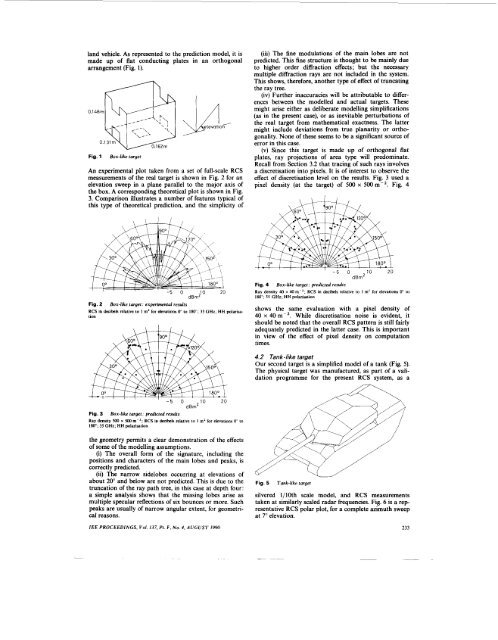





![Introduction to RF Stealth [Book Review] - Antennas and ...](https://img.yumpu.com/16857890/1/190x245/introduction-to-rf-stealth-book-review-antennas-and-.jpg?quality=85)

